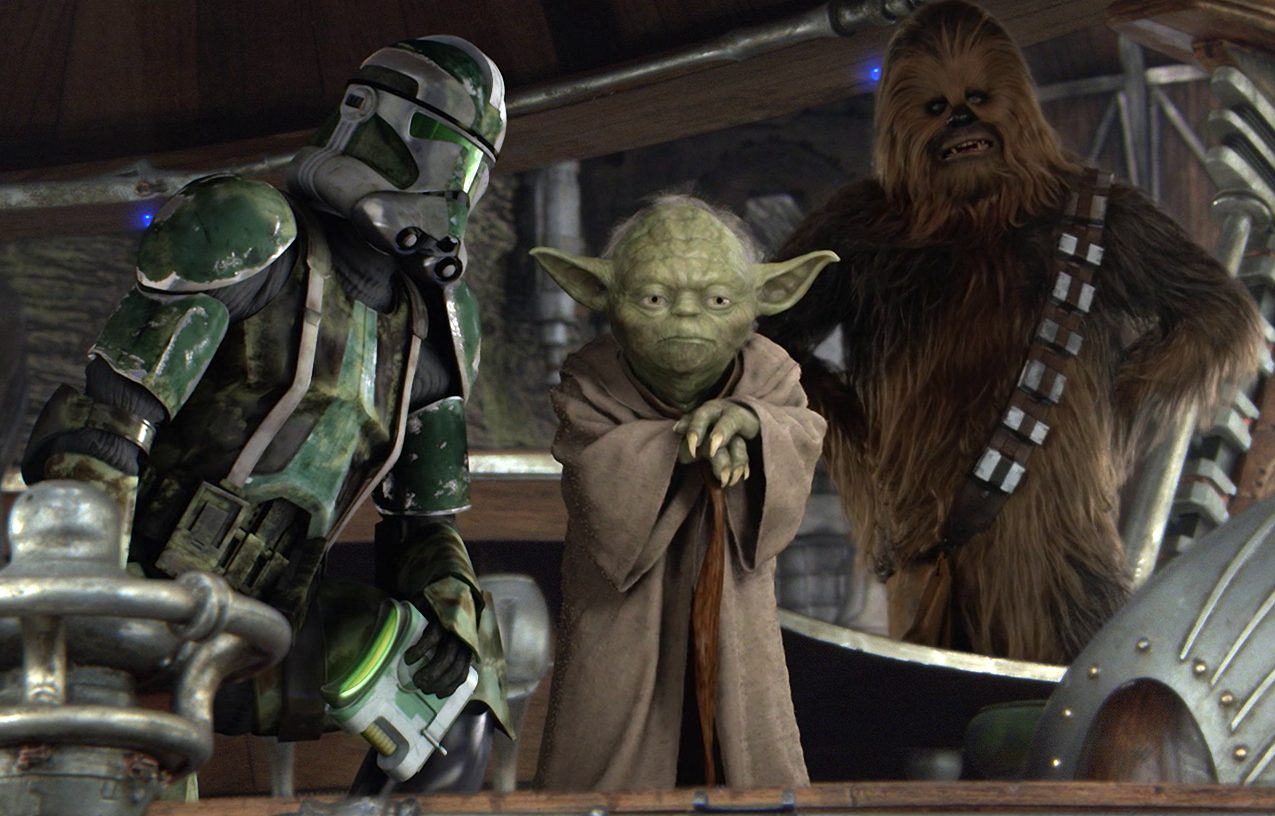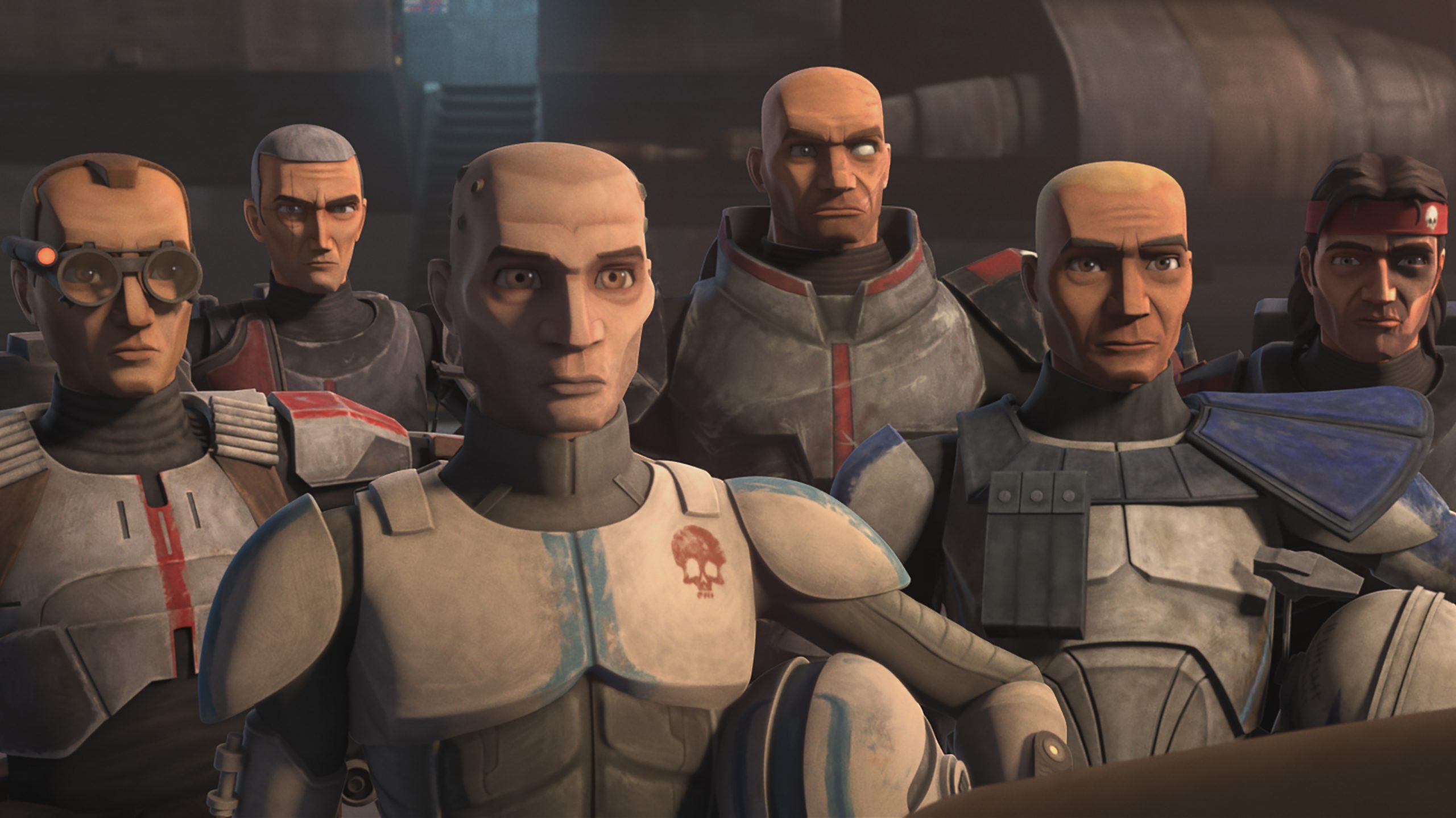From the start, George Lucas had a specific idea in mind for the look and feel of the foot soldiers of his Galactic Empire. The Stormtrooper were to invoke specific imagery from real-world wars: the “Imperial people to look efficient, totalitarian, fascist” according to military historian and costume designer John Mollo in The Making of Star Wars. Designed to look a bit like skeletons, the stormtroopers made a terrifying appearance in A New Hope, swarming into a captured Rebel ship, and stepping over the bodies of their fallen comrades.
The stormtrooper is one of the most iconic images from Star Wars, and subsequent sequels, prequels, side-quels, tie-in novels, video games, and comic books have reinforced the imagery and design language of that original suit of armor. A New Hope alluded to their industrial and uniform nature with a throwaway reference to “the Clone Wars.”
Years later, Lucas depicted that conflict, and unveiled its horrifying nature. Millions of men, cloned from a single bounty hunter, were bred for one purpose: war. When we first see them in action, kitted out in white armor for the Battle of Geonosis in the film’s climax, they’re ruthlessly efficient against their robotic enemies, taking out droids, and showing no remorse for their fallen clone brothers.
For all that Star Wars is about a titanic battle between good and evil, the introduction of the clone troopers injected a considerable dose of moral ambiguity into the franchise, and when Lucas launched The Clone Wars animated series in 2008, it did something interesting: it humanized the men under the masks and developing one of the franchise’s most complicated and compelling stories.
In the ramp up to the 1977 release of A New Hope, early reports and newspaper captions mistook stormtroopers for robots. It’s not hard to see why: Their white armor, precise marching, and adherence to authority strips away any trace of individuality. Inherent lethality came with the look of efficiency.
But for all that uniforms removed the appearance of self from the battlefield, Lucas imagined real men and women putting on the uniforms. The stormtroopers were people with complex beliefs, intentions, and motivations, none of which a suit of armor can entirely erase away. Pieces of humanity do leak out from under the helmets: the two bored troopers gossiping about drills and the new VT-16 (which saw a fun nod in Rogue One), and later, in the opening moments of J.J. Abrams’ The Force Awakens, we watch as one stormtrooper, moved and overwhelmed by the violence on the battlefield, strips off his helmet and decides to desert. Later in the trilogy in The Rise of Skywalker, we learn that he isn’t the only one: other troopers were compelled to lay down their arms during battle, unable to comply with their horrific orders.
But it was with Lucas and Dave Filoni’s Clone Wars series in which we see this complicated story play out in greater detail.
Attack of the Clones introduced the lab-made soldiers, and Revenge of the Sith showed their evolution. From the film’s earliest production meetings Lucas indicated that he wanted the troopers to be distinctive and individualized, hinting that they had developed their own unique personalities over the course of the war, leading to armor with distinctive color patterns.

Some authors had previously taken a shot at looking at the lives of the Empire’s rank and file, like with Doug Beason’s short story “When the Desert Wind Turns: The Stormtrooper’s Tale.” But with Lucasfilm’s Clone Wars publishing project, authors were able to flesh out the troopers into fully-formed characters.
One early tale, Aaron Allston’s “The Pengalan Tradeoff,” demonstrates the shift from nameless soldiers to individuals. The story follows a Republic Intelligence agent named Joram Kilthe, who’s assigned to an squad troopers embarking on a planetary invasion. When their gunship is downed by enemy fire, he sees the ruthless efficiency of the clones firsthand: When Joram works to figure out their best route out on foot, he realizes that they would need to walk for three or four days to reach safety.
“More than that, sir, unless we sacrifice our injured man. Let him be captured or put down ourselves. He can’t walk.”
“Put him down.” Joram winced at the cold-blooded terminology. “How do you feel about the prospect of putting him down, trooper?”
The trooper looked uneasy.” If we have to, it’s his duty, and ours sir. But we won’t do it if we don’t have to.”
As Joram spends more time with his cloned companions, he discovers that despite their identical appearances, they’re very much individuals: he prompts them to give themselves nicknames: Tooth, Hash, Digger, Mapper, and Wrench. By the time they escape from the planet, Joram realizes that they’re not entirely that different.
Some subsequent novels, most notably Karen Traviss’ Republic Commando series, took a similar track. A tie-in to the Republic Commando video game, her first novel, Hard Contact, followed another specialized squad of clone troopers as they embark on a mission to an enemy-held planet, only to be separated from one another when their landing vehicle crashes.
Where a typical tie-in novel might be a superficial retelling of a video game or movie, Traviss’ novel ended up being a thoughtful meditation on the nature of warfare and the impact it had on the people who waged it. Her clones, Niner, Darman, Fi, and Atin, are all orphaned from their original units and through the eyes of a Jedi Padawan that they link up with, Traviss explores the brutal nature of their conditioning and training, follows them as they work to come to terms with the purpose for which they’ve been bred, and reinforces their individuality.
Clones might have looked utterly standardized to outsiders, but every squad was altered slightly by the cumulative effects of its experiences, including influences of trainers.
Moreover, Traviss instilled a sense of agency within the clones, especially as they begin to understand the horrific purpose for their entire existence. While the troopers in Revenge of the Sith obey the order to kill any of their Jedi commanders on site, Traviss slips in an alternative motivation: the troopers are taking their existence into their own hands, killing the people who used them as tools in a brutal war.
Many of those themes carried over into The Clone Wars animated series in 2008, which introduced legions of named clone troopers: Echo, Blitz, Colt, Fives, Hammer, Havoc, Denal, Shiv, Boil, Comet, Draa, Fives, Hardcase, Jek, Jesse, Kix, Scythe, Spark, Squad, Waxer, Sinker, Boost, Dogma, Tup, Keeli, Lock, Bow, Thire, and most importantly, Captain Rex. From the show’s first episode, Filoni worked to highlight the humanity of the troopers, as Yoda invites a group of troopers to remove their helmets, telling them that he recognizes that despite their identical appearances, they’re individuals. Removing their helmets, we see that they have different haircuts, tattoos, and names.
Alongside mainstay characters like Anakin Skywalker, Obi-Wan Kenobi, Yoda, and others, Rex provided a useful viewpoint for audiences. Fiercely trained and conditioned for loyalty to the Republic, he chastised a deserter early in the war, and threatened to report him. The deserter (who adopted the name Cut Laqwuane) countered by explaining the circumstances of his flight, underscoring the predicament they were born into: “Everyone I cared about, my team, was gone. I was just another expendable clone waiting for my turn to be slaughtered in a war that made no sense to me.”

Rex’s ideology shifts as the war stretches on. During the Umbara arc in Season 4, he and the men under his squad get a new, brutal commander, General Krell, who addresses them by their numbers, and who sends them headlong into situations where they know they’ll be slaughtered. It’s a profound moment for Rex, who later muses: “I used to believe that being a good soldier meant doing everything they told you. That’s how they engineered us. But we’re not droids. We’re not programmed.”
When issued impossible orders, he explodes at Krell: “I followed your orders. Even in the face of a plan, that was, in my opinion, severely flawed. A plan that cost us men. (takes off his helmet) Not clones! Men! As sure as it is my duty to remain loyal to your command, I also have another duty: to protect those men.”
This is one of the biggest contributions that The Clone Wars brings to the Star Wars franchise. While the series rehabilitates the weaker parts in the Prequel trilogy, it breaks away from the light-vs.-dark dichotomy that defines the franchise. By looking at the clones not just as an avenue for more action but as a way to look at the horrors of war, Filoni and Lucas were able to tell a story that none of the prior Star Wars movies had actually been able to tell, despite their namesake. By exploring the war through the eyes of its combatants, they harken back to some of the real-world wars that inspired the first film, and in turn, tell some of its most emotionally-charged stories in the franchise.
